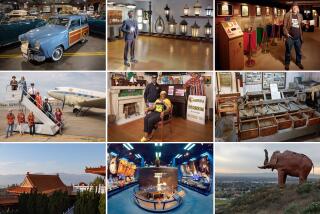The Connoisseur
- Share via
Walsh uprooted himself from the cultivated corridors of the East Coast and headed for the wilds of Malibu. In a move that many considered risky, he resigned as curator of paintings at Boston’s venerable Museum of Fine Arts--the kind of job one might keep for a lifetime--to take charge of a fabulously wealthy Southern California upstart.
Walsh’s appointment as director brought new respect to the J. Paul Getty Museum, whose Roman-style villa had often been ridiculed as a rich man’s folly. The trust that oversees the museum had received a fortune by then worth about $1.5 billion, which gave Walsh an unprecedented opportunity to shape an eccentric oil baron’s collection into a cultural stronghold. But he had a lot of work to do.
“We inherited a fairly small, very specialized and definitely spotty collection,” Walsh says. “Getty bought Greek and Roman antiquities out of an interest in archeology and antiquity. But he didn’t like to be reminded of death, so he didn’t buy funereal art. That cuts out a whole lot, including sarcophagi, on which some of the greatest of all relief sculpture is found. He didn’t care much about Greek vases or the so-called minor arts--goldsmiths’ and silversmiths’ work--and he didn’t pay attention to prehistoric art.
“He collected French furniture and decorative arts because that, again, was an era of art history that he identified with, and--like antiquities--it was cheap. But he came up light on the Neoclassical end. And the collection didn’t have all it needed to furnish rooms as they were in the 18th and 19th centuries.”
When it came to paintings, Getty’s third major area of collecting, the situation was far worse. “He was very stingy with paintings,” Walsh says. “He put up the money for a handful of very fine pictures--Rembrandt’s ‘St. Bartholomew,’ Carpaccio’s ‘Hunting on the Lagoon,’ the great Genoese man [‘Portrait of Agostino Pallavicini’] by Van Dyck. But it’s a short list.”
Walsh and his curators got busy, and the fruits of their labors have made big news. Among their coups are paintings by Van Gogh, Cezanne, Poussin, Rembrandt, Fra Bartolommeo; a massive cache of photographs; and an extraordinary medieval illuminated manuscript known as the Stammheim Missal. At the same time, the press has made much of the Getty’s failures to wrest major artworks away from England, including paintings by Sienese master Duccio and Bolognese artist Guercino, and a Neoclassical marble sculpture by Antonio Canova.
But now Walsh is looking forward to the opening of the new Getty Museum in Brentwood, and he likes what he sees. Visitors won’t get a full view of the Getty’s antiquities holdings until 2001, when the old museum in Malibu reopens after a renovation. But examples will be available in a temporary exhibition, “Beyond Beauty: Antiquities as Evidence,” while the new museum’s permanent collection galleries present European paintings, sculpture, drawings, manuscripts and decorative arts, plus photographs from Europe and America.
“What’s radically different in the new museum is that the collection is bigger, broader and vastly more important than it was,” Walsh says. “Even for people who have followed the collection over the last dozen years in Malibu, I think there is going be a feeling of complete amazement. Things I thought I knew, things I’ve seen dozens and dozens of times, seem new to me. It’s partly the setting, partly the light and partly that we have great things we hadn’t been able to show.
“Again and again in the French decorative arts galleries, you turn a corner and boom, you see something that wasn’t ever shown, whether it’s a whole suite of tapestries, a great piece of furniture or an entire room. Even in the collection that’s most familiar, the paintings collection, there’s no gallery that doesn’t have one--or several--paintings that have either been in storage or on loan somewhere because we didn’t have room for them, or we had just bought them.”
Walsh also expects visitors to be stunned by the six new sculpture galleries. In addition to figurative works in bronze and marble, the museum will display its little-known collection of pietre dure, mosaic-like compositions, tables and clocks made of precious and semiprecious stones. “We probably have the best collection in this country of pietre dure work made in Florence and Rome,” he says.
In addition, the museum will display larger selections of manuscripts, drawings and photographs. Now that the collections have breathing space in a more coherent context, curators can present more adventurous exhibitions, Walsh says.
The collection’s evolution doesn’t entirely match Walsh’s expectations, however. He thought medieval sculpture would be available, but next to nothing of importance has come up for sale. The same is true of great 18th century paintings. “Wouldn’t you have imagined that by now we would have found a wonderful Watteau or bought a really spectacular Fragonard and some Bouchers? Not one. And to my knowledge, not one of enough importance has come on the market,” he says.
What’s more, the boom of the 1980s and the inflation it brought meant that even the Getty couldn’t buy everything it desired. But Walsh expresses no regrets: “I don’t think many of our visitors know or care what they are not seeing. And I’m pretty optimistic, at least in some areas we collect, because we know there are still great things in private hands.”
Furthermore, the Getty is young, he says. “Because we have moved into spectacular new buildings, it’s tempting to think we have finished the collection. If anything, all this proves is we’ve done pretty well. It’s going to take us years and years--and untold amounts of money--to realize our potential. We have passed a way station, but it’s a long road ahead.”
More to Read
The biggest entertainment stories
Get our big stories about Hollywood, film, television, music, arts, culture and more right in your inbox as soon as they publish.
You may occasionally receive promotional content from the Los Angeles Times.










